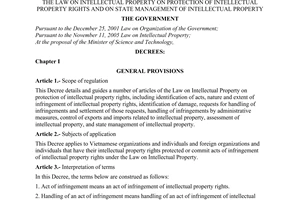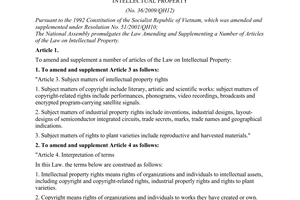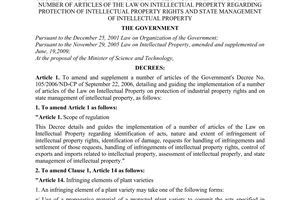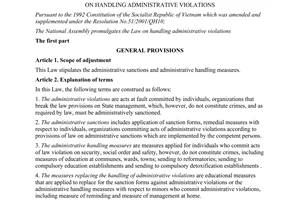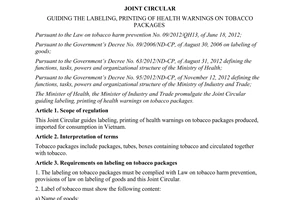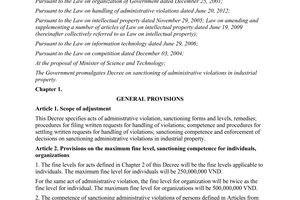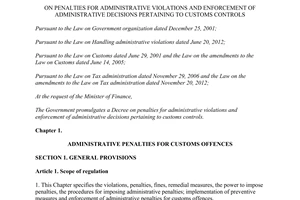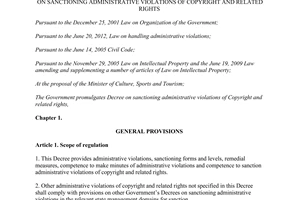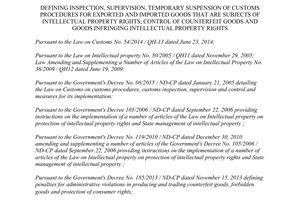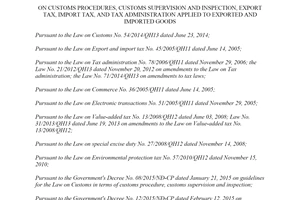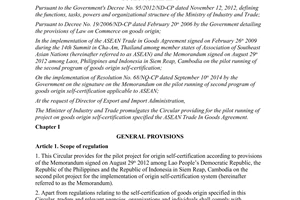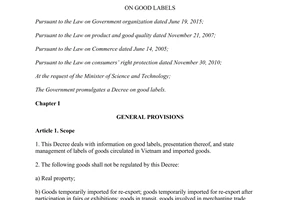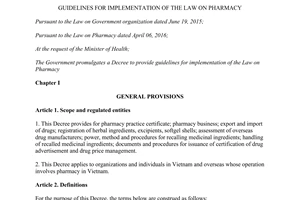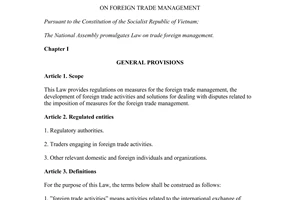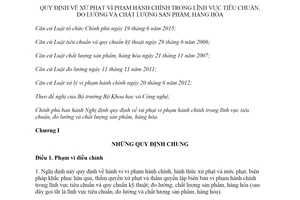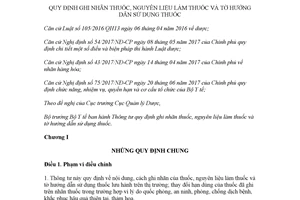Nội dung toàn văn Official Dispatch 5189/TCHQ-GSQL 2019 determination of origin of goods
|
MINISTRY OF
FINANCE |
SOCIALIST
REPUBLIC OF VIETNAM |
|
No. 5189/TCHQ-GSQL Re. inspection and determination of origin of goods; prevention and control of fraud and counterfeiting of goods origin, labeling, infringement on intellectual property rights and illegal transshipment. |
Hanoi, August 13, 2019 |
To: Customs Departments of cities and provinces.
In the course of monitoring, administration, oversight, control, post-clearance inspection and assessment pertaining to origin and labeling of goods and goods demanding protection of intellectual property rights, the General Department of Customs has discovered several acts of fraud and counterfeiting of origin of goods, illegal labeling of goods, infringement upon intellectual property rights and illegal transshipment of exported and imported goods. In addition, countries in the region and around the world have made major changes in trade policies aimed at trade protectionism, such as tax increase, application of technical barriers to protect domestic production; especially, the US - China trade war has a great impact on Vietnam's economy. It is forecasted that goods coming from countries imposing high tariff rates are more likely to find ways to be illegally transshipped into Vietnam and to pirate Vietnamese origin and then being exported to major markets to evade safeguard measures. These acts result in risks to Vietnam's exports when they are investigated by countries, subject to anti-dumping, safeguard and countervailing duties, harming Vietnamese manufacturers and losing their reputation in international markets or restricting exports to these markets. Several goods have already been affected by safeguard measures, including cold rolled steel coil, stainless steel coil, galvanized steel, aluminum extrusion, coated steel, etc.
With the aim of following direction from the Ministry of Finance, enhancing customs inspection and supervision, actively discover, prevent and handle fraudulent and counterfeiting acts on origin of goods, labeling of goods, infringement on intellectual property rights and illegal transshipment; raising awareness and capability of complying with laws on trade remedies, rules of origin and labeling of goods, protecting intellectual property rights, improving compliance with laws of importing and exporting enterprises, the General Department of Customs hereby requests its affiliates and subsidiaries, and Customs Departments of cities and provinces, to follow the following instructions:
I. Legal bases for inspection and verification of origin of goods, labeling of goods, protection of intellectual property rights and illegal transshipment of goods
Customs authorities shall check and determine the origin of goods in order to apply special preferential tariff rates in strict compliance with international commitments on preferential tariffs, take control of goods labeling and protection of intellectual property rights for imports and exports; prevent fraudulent and counterfeiting acts on goods origin, labeling of goods in contravention of regulations, illegal transshipment during the process of implementation of customs procedures and after post-clearance inspection and assessment according to the following legislative instruments:
1. Goods origin
a) Clause 1 and clause 2 of Article 27 in the Law on Customs dated June 23, 2014, regulating customs authority’s powers over inspection and determination of origin of imported and exported goods;
b) Clause 2 of Article 35 in the Law on Foreign Trade Management dated June 12, 2017, regulating that the Ministry of Finance shall direct the customs authority to verify origins of imports and exports when going through the customs procedures in accordance with regulations of law on customs;
c) Article 29 in the Government's Decree No.08/2015/ND-CP dated January 21, 2015, prescribing details and measures for implementation of the Law on Customs regarding customs procedures, customs inspection, supervision and control, which regulates customs authorities shall carry out physical verification of goods for determination of origins of goods;
d) Article 32 in the Government’s Decree No. 31/2018/ND-CP dated March 8, 2018 elaborating on the Law on Foreign Trade Management regarding origin of goods that regulated powers of the Ministry of Finance over inspection and verification of origin of goods of importing and exporting traders during the process of implementation of customs procedures, delivery of information for verification with issuing agencies, establishment of inspection delegations working abroad, formulation of legislative instruments, implementation of rules, design of communication networks, reporting regimes, development and management of database systems supporting and providing advantage to entities tasked with inspecting origin of exported and imported goods;
dd) Circular No. 38/2015/TT-BTC dated March 25, 2015 of the Minister of Finance on customs procedures; customs inspection and supervision; export and import tariff and management of import and export duties (which are amended and supplemented in the Circular No. 39/2018/TT-BTC dated April 20, 2018);
e) Circular No. 38/2018/TT-BTC dated April 20, 2018 of the Minister of Finance regulating determination of origin of exports and imports, authority over determination of origin of exports and imports granted to customs authorities and other relevant documents;
g) Documents locally legalizing rules of origin according to international treaties of which the Socialist Republic of Vietnam is a member state.
2. Labeling of goods and protection of intellectual property rights
a) Law on Customs dated June 23, 2014 (Article 73 through Article 76);
b) Law on Intellectual Property Rights dated June 29, 2009;
c) Government's Decree No. 105/2006/ND-CP dated September 22, 2006 elaborating and providing guidance on implementation of certain Articles of the Law on Intellectual Property Rights; the Government's Decree No. 119/2010/ND-CP dated December 30, 2010 on amendments and supplements to Decree No.105/2006/ND-CP;
d) Government’s Decree No. 43/2017/ND-CP dated April 14, 2017, regulating product labels;
dd) Circular No. 13/2015/TT-BTC dated January 30, 2015 of the Ministry of Finance, regulating inspection, supervision and temporary suspension of customs procedures for imports and exports subject to requirements for intellectual property projection, counterfeit goods and goods that infringing upon intellectual property rights.
3. Penalties for administrative violations
a) Law on Intellectual Property Rights dated June 29, 2009;
b) Law on Penalties for Administrative Violations dated June 20, 2012;
c) Government’s Decree No. 185/2013/ND-CP dated November 15, 2013, regulating penalties for administrative violations arising from trades, production and sale of counterfeit goods, prohibited goods and protection of customer’s interests;
d) Government’s Decree No. 99/2013/ND-CP dated March 29, 2013, regulating administrative penalties for violations arising in the intellectual property sector;
dd) Government’s Decree No. 131/2013/ND-CP dated October 16, 2013 on administrative penalties for violations arising from copyrights and associated rights;
e) Government’s Decree No. 127/2013/ND-CP dated October 15, 2013, regulating administrative penalties for violations and enforcement of administrative decisions in the customs sector; Government’s Decree No. 45/2016/ND-CP dated May 26, 2016 on amendments and supplements to the Decree No. 127/2013/ND-CP ;
g) Government’s Decree No. 119/2017/ND-CP dated November 1, 2017 on penalties for administrative violations arising in the product and commodity standard, measurement and quality sector.
II. Fraudulent and counterfeiting schemes and practices of origin of goods, illegal labeling of goods, infringement on intellectual property rights and illegal transshipment of goods
1. Labeling of goods and infringement on intellectual property rights over goods
a) Goods produced abroad upon arrival in Vietnam have already shown such tags as "Made in Vietnam", "Manufactured in Vietnam or "Product of Vietnamese origin", etc., or information about trademarks, main office addresses, websites and warranty service centers in Vietnam on products and/or product packages or warranty forms for domestic consumption or exporting purposes;
b) Goods that are imported from foreign countries, identified by product labels or indicated as being produced abroad or do not show countries of origin on their labels are re-labeled to say “Made in Vietnam” or “Manufactured in Vietnam” or “Product of Vietnamese origin”, etc. before they are freely sold and consumed on local markets;
c) Because there is none of legislative documents under which secondary labeling at the customs clearance stage is required for import into Vietnam, identification marks, packages and names of goods without legal secondary labels can be changed for domestic consumption purposes;
d) Goods with copyrighted brands which are forged have been imported;
dd) Customs transit has been misused for transportation of counterfeit products, goods infringing upon intellectual property rights or goods with pirated origin of Vietnam.
2. Goods origin
2.1. Goods that are imported into Vietnam to receive special preferential tariff rates under Free Trade Agreements
a) Use fakes or invalid C/Os to be submitted to meet customs requirements;
b) Provide incorrect C/O information to receive special preferential tariff rates to complete customs procedures. For example, falsifying regional value contents (RVC), Change in Tariff classification criterion (CTC),…, completing the box No. 1 (with respect to C/O Form E) with incorrect C/O holders, or giving wrong invoices at the box No. 10, etc.
2.2. Vietnam's exported goods
a) Although Vietnamese enterprises (including FDI enterprises) import input materials, semi-finished products, knock-down kits or components for production, manufacturing and assembling of products, whether not processed, manufactured or only treated at simple processing, manufacturing or assembling stages, which fail to meet prescribed origin criteria, they write Vietnamese origin in customs declarations or on product labels, or legalize all documents submitted to apply for certificates of origin of Vietnam when exporting these products;
b) An enterprise establishes multiple companies each of which imports several knock-down kits, components or removable parts for assembling or selling products which are processed and assembled by other enterprises at the simple stages failing to meet prescribed origin criteria, but show that they are made in Vietnam or origin of Vietnam on their labels for domestic consumption, consumer fraud or deception or for export;
d) Importing enterprises import goods showing foreign countries of origin that are transshipped via Vietnam to legalize their customs documentation or apply for certificates of origin, and then are exported to third countries;
dd) Importing and exporting enterprises take advantage of loose regulations on grant of C/Os to legalize application packages for grant of C/Os, such as not declaring origin of products imported as input materials, falsely signing contracts to purchase domestic input materials, using VAT invoices for different customs declarations and rotating applications for grant of C/O.
III. Inspection, supervision and control of origin, labeling of goods, intellectual property protection for imported and exported goods
Based on information about enterprises, types of exported and imported goods at high risks of fraud and counterfeiting of origin, labeling of goods, infringement on intellectual property right, illegal transshipment, channeling criteria on the customs system and other information, Customs Departments of provinces and cities may direct Customs Subdepartments and their subsidiaries to take measures to inspect, supervise and control origin, labeling of goods, intellectual property protection and illegal transshipment of imports and exports according to relevant legislative documents, customs procedures for exported and imported goods annexed to the Decision No. 1966/QD-TCHQ dated July 10, 2015, procedures for inspection and determination of origin of imports and exports annexed to the Decision No. 4286/QD-TCHQ dated December 31, 2015 of the General Department of Customs. In addition, the followings must be strictly controlled:
1. Customs Subdepartment's processing of application for customs clearance
1.1. Processing of application for clearance of imported goods:
a) Registration of customs declarations for imported goods:
Customs authorities shall not register customs declarations for imported goods if customs declarants do not fill in the box "code of country of origin" shown in import customs declarations.
b) Inspection of customs declarations:
b.1) Checking provided information about origin of goods on import customs declarations;
- Provided information about country of origin: It is mandatory to provide information about code of country or territory where goods are manufactured or made according to the UN/LOCODE table released by the General Department of Customs;
- Provided information about goods: It is mandatory to provide full and accurate information about names, labels, quality specifications, technical parameters, models, numbers or codes, particularities and utility of goods according to requirements specified in the Appendix II to the Circular No. 38/2015/TT-BTC (amended and supplemented in the Circular No. 39/2018/TT-BTC);
b.2) If customs declarants submit C/Os in compliance with the Circular No. 38/2018/TT-BTC , customs authorities shall carry out the following inspections:
b.2.1) Checking and comparing stamps and/or signatures affixed to C/Os with sample stamps of competent C/O-issuing entities and/or signatures of competent C/O-issuing persons which have already been informed by the General Department of Customs to Departments of Customs of cities or provinces (except C/O sent via the national single-window portal) in order to ensure provided stamps or signatures are valid;
b.2.2) Checking the validity period of C/O;
b.2.3) Verifying information about importers: This verification is to ensure that C/Os show importer’s names and addresses which are the same as those provided in customs declarations;
b.2.4) Checking provided information about quality specifications, technical parameters, components, models, codes and signs, particularities and utility of goods in submitted import customs declarations which are stipulated in the Appendix II to the Circular No. 38/2015/TT-BTC (amended and supplemented in the Circular No. 39/2018/TT-BTC) in order to determine whether these information are conformable to those provided in customs documentation;
b.2.5) Checking provided information about names of goods, description of goods, quantity, HS code and value with customs documents in order to verify whether information provided by customs declarants are valid, consistent and form sufficient basis to identify origin of goods, specifically including:
- Cargo name and description: Name and description of goods printed in C/Os must be conformable to those provided in import customs declarations, and documents contained in customs documentation;
- Cargo quantity: Checking and verifying information about quantity of goods provided in C/Os with those provided in import customs declarations in order to determine the number of goods obtaining special preferential tariff rate:
+ If the actual quantity, tonnage or volume of imported goods is greater than the one specified in the submitted C/O, customs officers shall consider applying special preferential tariff rates based on the latter;
+ If the actual quantity, tonnage or volume of imported goods is less than the one specified in C/Os, customs officers must accept the C/O for the actual number of imported goods;
- HS code: Checking and verifying information about HS codes specified in C/Os with those provided in customs declarations in order to determine whether declared information about HS code are relevant;
- Customs value: Checking information about value of goods specified in C/Os with those provided in customs declarations;
If any difference between value specified in C/Os and value specified in documents included in customs documentation, such as commercial invoices, etc. arises because of the fact that goods imported into Vietnam are declared based on FOB value (however, they are declared based on CIF value on C/Os) but are declared based on CIF value upon import into Vietnam, C/O will remain valid;
- Commercial invoices: Checking and verifying information provided on commercial invoices in order to determine their relevance to those provided in import customs declarations and documents included in customs documentation;
If commercial invoices issued by third parties are given in C/Os, customs officers must check information about invoicing numbers and date at the box No. 10; name and country of the invoicing company at the box No. 7, and marking of invoices issued by third parties in the box No. 13 of C/Os, to ensure their conformance to regulations laid down in Free Trade Agreements and other relevant legislative documents. Name and country of the third-party invoicing company must be consistent with name and country of the exporter given in import customs declarations.
b.2.6) Checking origin criteria:
b.2.6.1) Checking criteria for origin of goods specified in C/Os (according to criteria regarding value-added contents or criteria for conversion of HS codes or criteria for processing and manufacturing of goods or WO origin criteria, etc.) according to Circulars/Decisions promulgated by the Ministry of Industry and Trade to provide instructions on implementation of rules of origin in Free Trade Agreements and directions at the back of C/O in order to identify criteria for origin of goods;
b.2.6.2) Determining rules of origin applied to goods according to HS codes prescribed in relevant Free Trade Agreements, Decree No. 31/2018/ND-CP and Circular No. 05/2018/TT-BTC, specifically including:
- If customs declarants provide information about wholly obtained goods (WO): Customs officers must check conditions for meeting WO criteria of imported goods based on market, geographical, production procedure information, etc. in comparison with regulations laid down in Circulars/Decisions of the Ministry of Industry and Trade on WO origin in order to determine whether information about origin of goods that customs declarants have provided conform to regulations, and will not be required to consider origin criteria specified in the PSR list or common criteria (if any);
- If customs declarants state that goods are produced entirely in the territory of a member state from materials originated from one or multiple other member states (PE): Customs officers will not be required to take into account origin criteria specified in the PSR list or common criteria (if any);
- If customs declarants state that goods are not wholly obtained goods, origin criteria must be determined according to the following procedures:
+ If goods are in the PSR list, origin criteria must be determined according to regulations laid down in this list;
+ If goods are not in the PSR list, or Free Trade Agreements do not prescribe the PSR list, origin criteria must be determined according to common criteria.
b.2.7) Checking origin self-certification documents:
b.2.7.1) Checking forms of origin self-certification documents:
- Provided information about origin must be shown in commercial invoices or in other commercial evidence;
- As for origin self-certification documents specified in the Circular No. 28/2015/TT-BCT dated August 20, 2015 of the Ministry of Industry and Trade, regulating trial self-certification of origin of goods according to the Asean Trade In Goods Agreement and the Circular No. 27/2017/TT-BCT dated December 6, 2017 of the Ministry of Industry and Trade amending and supplementing the Circular No. 28/2015/TT-BCT , declaration of origin of goods must be documented in commercial invoices. Sample origin declarations shall be given in Article 7 of the Circular No. 28/2015/TT-BCT ;
- Checking adequacy of information required to be shown in origin self-certification documents under the provisions of Free Trade Agreements and instructional Circulars of the Ministry of Industry and Trade.
In case of self-certification of origin under the provisions of the Circular No. 28/2015/TT-BCT and the Circular No. 27/2017/TT-BCT amending and supplementing the Circular No. 28/2015/TT-BCT , customs officers must check the following compulsory information: origin self-certification codes (codes of licensed traders), HS codes, country of origin, origin criteria and signatures of persons vested with origin self-certification authority;
b.2.7.2) Checking information provided in origin self-certification documents:
- Checking and verifying trade name, address, trader’s origin self-certification code; goods name, HS code of goods, signature and validity period of origin self-certification license specified in origin self-certification documents with the list of traders informed by the General Department of Customs;
- Checking origin certificates and other information: The inspection form shall be similar to the one specified in instructions given in b.2.6, point 1.1, section III herein;
- If customs declarants submit digital C/Os to make up for the one not yet submitted before, customs officers must check digital C/Os under the instructions given in b.2.2 through b.2.6, b.2.8 of paragraph 1.1 of section III herein;
b.2.8) Checking information about the journey of the shipment specified in C/Os, bills of lading and other documents (if any) in order to ensure imported goods meet direct transportation requirements prescribed in Circulars/Decisions of the Ministry of Industry and Trade, providing instructions about Free Trade Agreements and Article 18 in the Circular No. 38/2018/TT-BTC .
If goods are in transit through a third-party country/territory which is not a member state of a Free Trade Agreement (with respect to AK-formatted C/O, through a member state), customs officers shall requests customs declarants to submit one of the documents evidencing that goods are kept intact in accordance with regulations laid down in clause 3 of Article 18 in the Circular No. 38/2018/TT-BTC ;
b.2.9) Checking and verifying information given in import customs declarations, documents included in customs documentation with data on imported goods with their intellectual property which have already been protected in order to determine whether these imported goods are infringing upon intellectual property rights;
If there is any suspicion that imported goods infringe upon intellectual property rights, customs officers can move on to customs procedures specified in Circular No. 13/2015/TT-BTC ;
c) In case of physical verification of goods:
c.1) Checking and verifying information about origin and labeling with information about origin or labeling of goods provided in import customs declarations, documents included in customs documentation, and results of inspection of customs documentation (if any);
c.2) Checking codes and bar codes of imported goods for the purposes of determining of country of origin;
c.3) Checking whether there is labels attached to goods or packages. If goods are label-free (except goods specified in clause 2 of Article 1 in the Decree No. 43/2017/ND-CP), customs officers may take actions stipulated in d.2.4 of point 1.1 of section III herein. If goods are labeled, labels must show full information required in the Decree No. 43/2017/ND-CP , specifically including:
c.3.1) Label must be displayed on goods, commercial packages of goods, must be placed in visible, conspicuous positions and must fully show required information without needing to remove other details or parts of goods;
c.3.2) Compulsory information must be displayed on goods label:
- Cargo name;
- Name and address of entity or person responsible for such goods;
- Origin of goods;
- Other information required to be provided depending on characteristics of goods specified in Appendix I to the Decree No. 43/2017/ND-CP and other relevant legislative documents;
c.3.3) As for several headings of imported goods directly affecting consumer's health, in addition to checking of information required to be shown in labels in accordance with regulations, primary labels must fully show the following required information:
c.3.3.1) In case of imported goods, including pharmaceutical products, medicinal ingredients, checking information shown in labels and instruction leaflets shall be subject to Circular No. 01/2018/TT-BYT dated January 18, 2018 of the Ministry of Health:
- Instruction leaflets are considered an integral part of label of a pharmaceutical product and are contained in external packages of that pharmaceutical product. If a pharmaceutical product does not have an external package, an instruction leaflet must be printed or mounted onto the package in direct contact with that medicinal product;
- Sizes of labels, texts and number shown on labels, color of texts, signs and images displayed on labels, languages and instruction leaflets shall be subject to Article 5 (except as provided in point b of clause 2 of Article 5) and Article 6 in the Circular No. 01/2018/TT-BYT mentioned above;
- Information required to be shown on labels of medicinal products, ingredients and instruction leaflets must be printed in Vietnamese, except those information that may be written in other languages derived from Latin characters in accordance with clause 4 of Article 7 in the Decree No. 43/2017/ND-CP ;
- The primary label must display the following required information in full:
+ Name;
+ Quantitative composition, content, concentration or amount of drug substances or herbal ingredients in pharmaceutical formulation;
+ Batch lot;
+ Manufacturing date;
+ Expiration/ best before date;
+ Dosage form, except medicinal ingredients;
+ Packing size, quality standards;
+ Indications for use, use instructions and contraindications;
+ Drug use signs and warnings during use of pharmaceutical products;
+ Name and address of pharmaceutical manufacturer;
+ Origin of pharmaceutical product.
If ingredient is drug substance, herbal ingredient or semi-finished pharmaceutical product containing drug substance or herbal ingredient in the List of narcotic, psychotropic drug substances, precursor drugs, toxic drug materials, toxic herbal ingredients, radioactive drug materials, other than those information subject to inspection as mentioned above, respective text lines must be shown on labels attached to external packages as follows: “Narcotic drug ingredients”, “psychotropic drug ingredients”, precursor drugs”, toxic ingredients", "toxic herbal ingredients", and "radioactive ingredients" must be printed in bold and framed on the main side of label where ingredient name is printed;
- Checking the remaining days to the expiration date of pharmaceutical product or imported drug ingredients at the customs clearance date as provided in clause 1, 2, 3 and 4 of Article 90 in the Government’s Decree No. 54/2017/ND-CP dated May 8, 2017, elaborating on several articles and implementation of the Law on Pharmacy, specifically including:
++ Minimum remaining days to the expiration date of pharmaceutical drugs, herbal drugs, traditional drugs, medicinal ingredients other than drugs or drug ingredients specified in Clause 3 of Article 90 in the Decree No. 54/2017/ND-CP which is determined on the date of customs clearance must be:
+++ 18 month if the official shelf life is longer than 24 months;
+++ 1/2 of the official shelf life if it is equal to or less than 24 months;
++ The minimum days to the expiration date of imported vaccines and biologicals other than those specified in Clause 3 of this Article when customs clearance is granted is 1/2 of the official shelf life;
++ Imported drugs/medicinal ingredients specified in Articles 67, 73, 74, 75, 82, 83, 84, 85, 86 and Clause 1b Article 68 in the Decree No. 54/2017/ND-CP must be unexpired when customs clearance is granted;
++ The Minister of Health shall consider permitting import of drugs/medicinal ingredients whose the remaining days to the expiration date are shorter than those specified in Clause 1 or Clause 2 of Article 90 in the Decree No. 54/2017/ND-CP but they are essential for prevention and treatment of diseases.
c.3.3.2) If imported goods are cereal products:
Customs officers must check that primary labels must fully show information required in Appendix I to the Decree No. 43/2017/ND-CP as follows:
- Quantity;
- Manufacturing date:
- Expiry date;
- Caution (if any).
c.3.3.3) If imported goods are food products:
Customs officers must check that primary labels must fully show information required in Appendix I to the Decree No. 43/2017/ND-CP as follows:
- Quantity;
- Manufacturing date:
- Expiry date;
- Ingredients or quantitative ingredients;
- Information and warning;
- Use instructions, instructions for storage of health protection foods;
c.3.3.4) If imported goods are food materials:
Customs officers must check that primary labels must fully show information required in Appendix I to the Decree No. 43/2017/ND-CP as follows:
- Name of food material;
- Quantity;
- Manufacturing date:
- Expiry date;
- Use and storage instructions.
c.3.3.5) If imported goods are cigarettes, customs officers must check that labeling of these products must be subject to the Joint Circular No. 05/2013/TTLT-BYT-BCT dated February 8, 2013 of the Ministry of Health in collaboration with the Ministry of Industry and Trade, providing instructions about labeling and printing out of health warnings on cigarette packs.
Checking that the primary label must display the following required information in full:
- Quantity;
- Manufacturing date:
- Caution;
- Expiration date;
- Code and barcode.
Notes: One of six health warning messages prescribed in Appendix to the Joint Circular No. 05/2013/TTLT-BYT-BCT mentioned above must be displayed on cigarette packs.
c.3.3.6) If imported goods are medical equipment:
Customs officers must check that primary labels must fully show information required in Appendix I to the Decree No. 43/2017/ND-CP as follows:
- Number of marketing authorization or import permit;
- Lot or serial number;
- Manufacturing date and expiration date: With respect to sterilization devices, consumables, reagents, adjusting substances, controlling materials and chemicals, their expiry date must be specified. In other cases, either manufacturing date or expiration date may be specified;
- Information about warning, use instructions, storage instructions and warranty service providers may be shown directly on labels of medical equipment or must be referred to labels of medical equipment for more details.
c.3.3.7) If imported goods are cosmetic products:
Customs officers must check that primary labels must fully show information required in Appendix I to the Decree No. 43/2017/ND-CP as follows:
- Quantity;
- Ingredients or quantitative ingredients;
- Lot number;
- Manufacturing date or expiry date/self life;
- With respect to products of which stability period is less than 30 months, expiry date is required;
- Use instructions, except as presentation forms clearly explain how to use these products;
- Information and warning.
c.3.3.8) If imported goods are alcohol:
Customs officers must check that primary labels must fully show information required in Appendix I to the Decree No. 43/2017/ND-CP as follows:
- Quantity;
- Ethanol content;
- Expiration date (if any);
- Storage instructions (required for wine);
- Caution (if any);
- Batch identification code (if any).
c.3.3.9) If imported goods are drinks (except alcohol):
Customs officers must check that primary labels must fully show information required in Appendix I to the Decree No. 43/2017/ND-CP as follows:
- Quantity;
- Manufacturing date:
- Expiry date;
- Ingredients or quantitative ingredients;
- Caution;
- Use instructions and storage instructions.
c.4) Checking information about intellectual property rights displayed on imported goods and comparing such information with data on customs systems in order to identify any act of infringement upon intellectual property rights;
c.5) Checking and defining whether goods are complete products or removables of complete products which are declared as input materials or knock-down kits;
d) Handling of customs inspection results:
d.1) In case of inspection of customs documentation
- If results of inspection of customs documentation have not yet formed sound grounds for determining origin of goods, any suspicious act of fraud or counterfeiting of goods origin or any act of violation against labeling, violation against intellectual property rights, customs officers must send a report to leaders of Customs Sub-departments to advise them to approve channeling changes for physical inspection;
- In case of discovery of any suspicious act of use of fake or invalid C/Os, customs officers can make referrals to smuggling control forces of their customer authorities in order to request them to conduct investigation, verification and clarification of any sign of violation and take permissible actions;
- With respect to imported shipments with submitted C/Os, if it is determined that provided information do not conform to origin criteria with the aim of receiving special preferential tariff rates after inspection of customs documentation or physical verification of goods (where available), such C/Os must be rejected in accordance with regulations in force;
d.2) In case of physical verification of goods
d.2.1) After physical verification of HS codes of imported goods for processing and manufacturing of products for export, if it is discovered that these imported goods are complete products or removable forms of complete products, but are defined as goods classified by HS codes of input materials and knock-down kits, customs officers must request importing enterprises to provide correct HS codes in accordance with regulations in force; or if there is any doubt that importing enterprises import these imported goods in multiple times, multiple shipments of components, knock-down kits only for the purposes of the simple processing or assembly which does not meet rules of origin for export, customs officers can make referrals to post-clearance agencies to schedule inspections at customs declarant's workplaces;
d.2.2) If it is discovered that goods in transit may be counterfeit goods or goods infringing upon intellectual property rights or using forged origin of Vietnam, customs officers must make referrals to smuggling control forces affiliated to the Smuggling Investigation and Prevention Department, or directly to the Department (with respect to major and complicated cases), in order to carry out further verification, inspection and imposition of prescribed sanctions in accordance with regulations in force;
d.2.3) If it is discovered that any violation relates to intellectual property rights, actions or sanctions prescribed in the Decree No. 99/2013/ND-CP , the Decree No. 131/2013/ND-CP and other related instructional documents must be imposed;
d.2.4) If imported goods are not labeled in accordance with the Decree No. 43/2017/ND-CP , penalties prescribed in clause 7 of Article 14 in the Decree No. 127/2013/ND-CP (amended and supplemented in clause 11 of Article 1 in the Decree No. 45/2016/ND-CP) must be imposed and referrals must be made to Vietnam Directorate of Market Surveillance for its further inspection and oversight of secondary labeling before they obtain marketing authorization;
d.2.6) If labels of imported goods do not fully show required information prescribed in clause 1 and 2 of Article 10 in the Decree No. 43/2017/ND-CP , prescribed penalties must be imposed and referrals must be made to Vietnam Directorate of Market Surveillance for its further inspection and oversight of secondary labeling before they obtain marketing authorization;
d.2.7) If imported goods (except imported goods which are returned, goods imported from free trade zones into domestic markets, imported goods which are packages used for wrapping products domestically produced in Vietnam) have labels saying that these imported goods are of origin of Vietnam, including "Made in Vietnam” or “Produced in/by Vietnam" or "Origin Vietnam", etc., penalties or sanctions applied to trades in goods with forged labels or packages which are prescribed in Article 13 in the Decree No. 185/2015/ND-CP must be imposed;
d.2.8) If it is discovered that customs declarants deliberately ignore provision of information, or provide false information, about origin of goods with the intent of tax evasion or tax fraud to the extent that no criminal actions must be taken, sanctions or penalties must be imposed in accordance with regulations in force.
1.2. Exported goods:
a) Checking information about origin of goods or trademarks/labeling of goods by customs declarants which are provided in export customs declarations:
- Provided information about origin of goods: Checking provided information about codes of country of origin at the box of description in export customs declarations according to instructions given in Appendix II to the Circular No. 38/2015/TT-BTC (amended and supplemented in the Circular No. 39/2018/TT-BTC);
- Provided information about trademarks/labeling of goods: Checking provided information about trademarks/labeling of goods at the box of description in export customs declarations according to instructions given in Appendix II to the Circular No. 38/2015/TT-BTC (amended and supplemented in the Circular No. 39/2018/TT-BTC) in order to ensure clear information about name of goods, quality specifications, technical parameters, signs/codes, particularities and useful functions of goods.
Customs authorities shall be allowed not to grant registration for customs declarations for exported goods if customs declarants have not declared information about origin, trademarks/labeling of goods at the box of description in export customs declarations in accordance with regulations in force.
b) In case of inspection of customs documentation:
b.1) Checking and verifying customs declarant’s provided information about name of goods, description, quantity, HS codes and origin with documents included in customs documentation in order to determine whether customs declarant’s provided information are valid, consistent and form sufficient grounds for determination of origin of goods; checking provided information about models and signs/codes of goods in export customs declarations to determine whether such information are conformable to those provided in documents included in export customs declarations;
b.2) If there is any suspicious fraud on origin with respect to goods processed or produced for export, customs officers must compare HS codes given in export customs declarations with those provided when carrying out import procedures (if possible);
b.3) Checking and verifying information given in export customs declarations, documents included in customs documentation with data on exported goods with their intellectual property which have already been protected in order to determine whether these exported goods are infringing upon the protected intellectual property;
c) In case of physical verification of goods:
c.1) Checking and verifying name of goods, label contents with customs declarant's information provided in export customs declarations and documents included in customs documentation.
c.2) With respect to exported goods displaying text lines, including “Made in Vietnam” or “Produced in/by Vietnam or “Origin Vietnam”, etc., on their packages, if it is discovered that there is any sign of fraud or counterfeiting of origin or illegal transshipment after physical verification of these exported goods, customs declarants shall be requested to give explanations and provide evidencing documents stipulated in clause 3 of Article 8 in the Circular No. 38/2018/TT-BTC , specifically comprising:
- C/O: 01 photocopy; or
- Manufacturing process: 01 photocopy; and
- Detailed list of costs of raw materials, input materials, value of output materials associated with invoices, documents evidencing sale and purchase of raw materials or input materials, which are required in case the "ad valorem” origin criterion is used: 01 photocopy; or
- Detailed list of raw materials, input materials or output materials, which are required if the “HS code conversion” origin criterion is used: 01 photocopy;
With respect to exported goods with submitted C/Os, if such C/Os do not form a basis to identify origin of these exported goods after customs inspection, customs officers must report to and recommend leaders of Customs Sub-departments to carry out verification at offices of organizations or entities issuing these C/Os in accordance with Article 9 in the Circular No. 38/2018/TT-BTC ;
With respect to exported goods without C/Os, if such C/Os do not form a basis to identify origin of these exported goods after physical verification, customs officers must report to and recommend leaders of Customs Sub-departments to seek decisions on inspection at manufacturing establishments from Customs Departments of provinces or cities under Article 10 in the Circular No. 38/2018/TT-BTC ;
While expecting results of inspection and verification of origin, application for customs procedures for exported goods may be processed and these exported goods may be cleared under the provisions of clause 4 of Article 8 in the Circular No. 38/2018/TT-BTC ;
c.3) Checking information about intellectual property rights for exported goods, comparing these information with data available on the system in order to determine whether there is any violation arising from these goods;
d) Handling of customs inspection results:
d.1) In cases where there is any suspicious sign of fraud or counterfeiting of origin, illegal transshipment after inspecting and verifying provided information about origin on export customs declarations with those information available on documents included in customs documentation, and customs declarants have provided evidencing documents specified in clause 3 of Article 8 in the Circular No. 38/2018/TT-BTC which fail to prove origin of these goods, customs officers must report to and recommend leaders of Customs Sub-departments to make channeling changes for physical verification of these goods, and make referrals to smuggling control forces under the control of these customs authorities to investigate, verify and clarify any suspicious sign of violation;
d.2) In cases where there is any suspicion that exported goods are infringing upon intellectual property rights after inspecting and verifying information provided on export customs declarations with those information provided in documents included in customs documentation, customs officers shall proceed to carry out customs procedures specified in the Circular No. 13/2015/TT-BTC ;
d.3) In cases where there is any suspicious sign of fraud and counterfeiting of origin, illegal transshipment of goods processed and produced for export, customs officers shall make referrals to post-clearance inspection agencies to carry out inspection at customs declarant’s offices;
d.4) If it is discovered that any violation relates to intellectual property rights, actions or sanctions prescribed in the Decree No. 99/2013/ND-CP , the Decree No. 131/2013/ND-CP and other related instructional documents must be imposed;
d.5) In cases where there is any suspicious sign related to issuance of C/Os as specified in point c of section II herein, customs officers must inform relevant C/O issuing offices to request them to take stricter measures to control issuance of C/Os.
2. Risk management units
a) Collect information, review export businesses under their jurisdiction in order to take initiative in identifying exported and imported goods or enterprises under their jurisdiction which pose high risks related to fraud and counterfeiting of origin, labeling of goods, infringement upon intellectual property rights or illegal transshipment and informing them to other specialized units under the control of customs authorities so that during-clearance, post-clearance, smuggling control and prevention measures shall be carried out.
b) Recommend setting up channeling criteria for inspection of enterprises that export or import goods at high risks related to fraud and counterfeiting of origin, labeling of goods, infringement upon intellectual property rights or illegal transshipment through collection and analysis of information and receipt of information from customs units.
3. Post-clearance inspection agency:
a) Collect, analyze and process information about goods and enterprises posing risks of fraud or counterfeiting of origin, labeling of goods and protection of intellectual property rights for exported and imported goods or illegal transshipment;
b) Identify posers of high risks in fraud and counterfeiting of origin, labeling of goods which is false or in breach of intellectual property rights or illegal transshipment in order to develop inspection plans according to instructions given in point 2.1 and 2.2 of section IV herein and upon requests of Customs Sub-departments. In addition to inspecting information under instructions given in point 1 of section III herein, this agency must carry out inspection according to instructions given in point 2.4, 2.5 and 2.6 of section IV herein.
4. Customs control agency
a) Carry out specialized customs control measures; evaluate situations, develop main and key plans and proposals for goods, enterprises or localities posing risks of fraud and counterfeiting of origin, labeling of goods, infringement upon intellectual property rights, illegal transshipment in order to prevent and combat smuggling, trade fraud, illegal transportation of goods across borders and other acts of violation against customs laws;
b) Collect, analyze and process customs information related to fraud or counterfeiting of origin, labeling of goods, infringement upon intellectual property rights or illegal transshipment;
c) Carry out patrolling or other specialized actions in order to prevent, discover and arrest smuggling, fraud or counterfeiting of origin, labeling of goods, infringement upon intellectual property rights or illegal transshipment according to the set schedule;
d) Collaborate with smuggling control forces within localities in order to perform duties to prevent and control smuggling, trade fraud, counterfeiting of origin, labeling of goods, infringement upon intellectual property rights or illegal transshipment of goods across borders;
dd) Carry out investigation, verification, clarification and impose actions or sanctions for cases requested by Customs Sub-department.
IV. Implementation duties
1. Customs Information Technology and Statistics Department:
a) Gather and input different sources of data according to criteria, including corporate code, name, number, date of customs declaration, trade type code, heading, HS code (6-digit level), unit of measurement, quantity, value, origin, export/import turnover, country of importation/exportation, entry/exit checkpoint, or Customs Sub-department in charge of carrying out customs procedures, from the following sources of information:
a.1) List of goods or enterprises generating suddenly increased export and import turnover (at the growth rate of 15%) within the first 6 months of 2019 corresponding to the same period of 2017 and 2018; in the next period, actively gather and input data according to the aforesaid criteria on September 30 each year;
a.2) List of goods or enterprises posing high risks in fraud or counterfeiting of origin or illegal transshipment, which is provided by the Customs Management Supervision Department;
b) Transfer collected data to the Customs Management Supervision Department, the Risk Management Department, the Post-Customs Clearance Inspection Department and the Smuggling Investigation and Prevention Department for implementation of relevant specialized measures;
c) Conduct researches into developing functions to link import customs declarations to export customs declarations with respect to processing and manufacturing of products for export in order to identify shipments suspected of fraud or counterfeiting of origin, illegal transshipment and software systems supporting updated information about fraud and counterfeiting of origin, labeling of goods, infringement upon intellectual property rights and illegal transshipment;
d) Cooperate with the Ministry of Industry and Trade and Vietnam Chamber of Commerce and Industry in connecting data exchange systems in terms of issuance of C/Os through the national single-window portal.
2. Post-clearance Inspection Department:
2.1. Identifying subjects of post-clearance inspections
a) Based on data provided by the Department of Customs Information Technology and Statistics, the Customs Management Supervision Department, the Risk Management Department and the Smuggling Investigation and Prevention Department, the Post-clearance Inspection Department shall analyze data, determine main goods or enterprises and those posing high risks that are subject to inspections or identification of origin in order to prevent any act of fraud and counterfeiting of origin, labeling of goods, infringement upon intellectual property rights or illegal transshipment according to the following criteria:
a.1) Enterprises abnormally increases their turnover of export to major markets and their turnover of import from countries subject to safeguard measures in comparison with the same period;
a.2) Newly-established or FDI enterprises abnormally increase their turnover of export to major markets;
a.3) Competence and production of exported products do not correspond to the quantity of imported goods; the frequency rate of import and export is suddenly increased during a specified period of time;
a.4) Imported and exported goods are the same as those of major markets applying safeguard measures against countries.
b) After defining the subjects of post-clearance inspections, where necessary, carry out consultation and collection of opinions from industry associations about enterprises or goods in order to form a basis to carry out post-clearance inspections at customs declarant’s offices.
2.2. Formulating inspection plans
a) Enterprises subject to immediate inspections:
a.1) Enterprises abnormally increases import goods from countries subject to safeguard measures, and export of goods to major markets;
a.2) Enterprises import or export goods in the list of goods from or to major markets applying safeguard measures against countries.
b) Department shall continue to analyze and screen enterprises under investigation in order to determine any suspicious sign of fraud or counterfeiting of origin, labeling of goods, infringement upon intellectual property rights or illegal transshipment.
c) Recommend the General Department of Customs to assign duties to local Customs Departments in order to carry out thematic post-clearance inspections at the General Department of Customs’ order.
d) With respect to import or export enterprises or imported or exported goods that need to be re-channeled for the purposes of inspection, supervision and control during the customs clearance process, the Department can recommend the leadership of the General Department of Customs to make referrals to the Risk Management Department in order to set channeling criteria for inspection purposes.
dd) With respect to enterprises or goods under investigation, verification or sanctioning process, Department may recommend the leadership of the General Department of Customs to make referrals to the Smuggling Investigation and Prevention Department to take such actions on these enterprises.
e) Recommend the General Department of Customs to assign duties to local Customs Departments of cities or provinces in order to carry out thematic post-clearance inspections at the General Department of Customs’ order.
2.3. The inspector commission shall be composed of: Customs Post-clearance Inspection Department, Customs Management Supervision Department and other related entities.
2.4. Inspection subject matters:
In addition to inspection of information referred to in Circular No. 38/2015/TT-BTC , and Circular No. 39/2018/TT-BTC amending and supplementing Circular No. 38/2015/TT-BTC , the latter has prescribed that, when determining origin of exported or imported goods, procedures for inspection of origin and procedures for post-clearance inspection currently in effect, the inspector commission shall carry out the following inspections:
a) Inspection and verification of documents included in customs documentation and other related documents:
a.1) Checking information provided on import or export customs declarations with documents included in customs documentation in order to determine whether information about imported or exported goods are sufficient and valid with particular attention paid to inspection of name of goods, business type code, HS code of goods; checking and verifying provided information about business type code, name of goods, HS code of exported goods with those about imported goods for determination of relevance and consistency;
a.2) Checking whether C/Os based on which special preferential tariff rates are applied meet origin criteria in accordance with regulations in force (if any);
a.3) Checking the list of costs of input materials or value of output products;
a.4) Checking sale and processing contracts (if processing services are rendered to foreign traders) or VAT invoices for sale and purchase of domestic raw materials or input materials (in case of domestic procurement);
a.5) Checking export permits (if any);
a.6) Checking inventory quantity, invoices for purchase of domestic goods, export contracts and reports on settlement of costs incurred from use of raw materials or input materials;
a.7) Checking the number of import or export customs declarations; the number of imported or exported goods; the frequency rate of import or export; interval between production of goods for export orders;
a.8) Checking payrolls, power and water consumption bills;
a.9) Where it is necessary to carry out inspection in order to determine whether enterprises pay insurance contributions to their staff, such inspection must take place at insurance agencies' office;
a.10) Checking accounting books and documents.
b) Checking manufacturing processes:
b.1) Request enterprises to present copies of manufacturing processes and description of activities for manufacturing of products;
b.2) Carry out physical inspection of production lines, including the number of production lines; the number and capacity of machinery or equipment; the amount of raw materials or input materials used in production lines through dispatch notes, the number of workers;
b.3) Checking methods for setting actual productivity norms of exported products (for example, if the productivity norm for a product is 1-1, this will mean that exported products are made at the simple processing or assembly stage);
b.4) Checking warehouses storing raw materials, input materials, finished products, wastes or scraps;
b.5) Checking production stages in order to ensure added value of goods;
c) Checking exported goods to determine whether they meet origin criteria according to the Circular No. 05/2018/TT-BCT dated April 3, 2018 of the Ministry of Industry and Trade, regulating origin of goods, specifically including:
c.1) In case of declaring WO exported goods:
c.1.1) Checking and defining places where exploitation, harvest, agricultural production, processing and manufacturing activities take place;
c.1.2) In case of purchase of domestic raw materials with VAT invoices, checking VAT invoices, Enterprise Registration Certificates or Business Licenses of manufacturers/suppliers of domestic raw materials; declarations prepared by manufacturers/suppliers of domestic raw materials;
c1.3) In case of purchase of domestic raw materials without VAT invoices, checking certificates that raw material sellers hold to find information about areas where production and exploitation activities take place, quantity and prices of products sold to traders (if any).
c.2) In case of declaration of exported products meeting PE origin criteria:
Checking declarations of origin submitted by manufacturers or suppliers of raw materials or input materials or goods of origin which are domestically produced;
c.3) In case of declaration of exported products meeting ad valorem rate (LVC, RVC) criteria:
Checking input invoices of raw materials with or without origin/ of unknown origin (CIF price or domestic sale invoices);
Checking whether production costs (including fixed costs, personnel costs, infrastructure costs, regular costs of enterprises, profits, etc.), goods value (including FOC price. In case of goods transported by road, equivalent prices shall be applied), applied accounting principles and formula for calculation of value of local content for calculation of rates that enterprises have declared are correct or not.
Checking declarations of origin submitted by manufacturers or suppliers of raw materials or input materials or goods of origin which are domestically produced;
c.4) In case of declaration of exported goods meeting goods code conversion (CC, CTH, CTSH) criteria:
Checking origin and HS codes of input materials; checking and identifying HS codes of finished products for comparison, checking and identification of origin of goods;
d) Checking conditions for direct transportation:
Checking information about the journey of the shipment specified in C/Os, bills of lading and other documents (if any) in order to ensure imported goods meet direct transportation requirements prescribed in Circulars/Decisions of the Ministry of Industry and Trade, providing instructions about Free Trade Agreements and Article 18 in the Circular No. 38/2018/TT-BTC. If goods are in transit through a third-party country/territory which is not a member state of a Free Trade Agreement (with respect to AK-formatted C/O, through a member state), customs officers shall requests customs declarants to submit one of the documents evidencing that goods are kept intact in accordance with regulations laid down in clause 3 of Article 18 in the Circular No. 38/2018/TT-BTC .
2.5. Post-inspection conclusion:
a) If there are sound and sufficient grounds for determining that enterprises commit acts of fraud or counterfeiting of origin or labeling of goods in breach of regulations, infringement upon intellectual property rights or illegal transshipment: The inspector commission must refer to section II about fraudulent and counterfeiting schemes and practices in order to give their conclusions on these violations;
a) If there are not enough sound and sufficient grounds for determining that enterprises commit acts of fraud or counterfeiting of origin or labeling of goods in breach of regulations, infringement upon intellectual property rights or illegal transshipment: Continue to collect information, set up database of import or export enterprises or imported or exported goods in order to take appropriate inspection or supervision measures, or direct relevant Customs Departments of cities and provinces to strengthen inspection, supervision or control of entry or exit shipments of import or export enterprises. In case where, after collection of information and monitoring of export and import activities of enterprises for a specified time period, the commission finds that import or export enterprises is suspicious of committing origin frauds, it must develop inspection plans to identify origin of goods at customs declarant's offices in the following years.
2.6. Handling of inspection results:
a) Request imposition of administrative penalties (if any);
b) Request correct information about origin of goods to be provided;
c) With respect to counterfeit goods or goods infringing upon intellectual property rights, impose actions or sanctions prescribed in regulations on counterfeit goods or goods infringing upon intellectual property rights;
d) Persuade competent entities and bodies not to issue C/Os for the next shipments and take measures to prevent illegal transshipment in accordance with Article 29 in the Decree No. 31/2018/ND-CP ;
dd) Inform the Ministry of Industry and Trade of frauds of these enterprises to cooperate in and recommend actions or sanctions (if any);
e) Make referrals to jurisdictional entities to investigate and take legal actions against offences related to tax fraud or evasion (if any).
2.7. Assigning duties to Post-clearance Inspection Department: Detect and handle 05 cases related to fraudulent or forged origin of goods in 2019.
3. Smuggling Investigation and Prevention Department:
a) Collect domestic and foreign information about enterprises, exported or imported goods suspected of fraud or counterfeiting of origin, labeling of goods or illegal transshipment. Transfer information about enterprises or goods posing high risks to the Customs Post-clearance Inspection Department, the Risk Management Department, the Customs Management Supervision Department and Customs Departments of cities and provinces so that they carry out relevant specialized measures;
b) Carry out inspection, verification and imposition of actions or sanctions on enterprises found to import or export high-risk goods, or enterprises suspected of fraud or counterfeiting of origin of goods, labeling of goods, infringement upon intellectual property rights or illegal transshipment after receipt of information transferred from specialized units (if any);
c) Cooperate with functional units to carry out investigation, verification and collection of information to clarify any suspicious sign with respect to complicated cases;
d) Report to the General Department of Customs on results of inspection, verification or handling of cases; after receipt of approval from the leadership of the General Department, transfer these results to the Customs Management Supervision Department, the Risk Management Department or the Customs Post-clearance Inspection Department.
dd) Assign the Smuggling Investigation and Prevention Department to investigate, verify and handle 05 cases of fraud or counterfeiting of origin of goods in 2019.
4. Risk Management Department:
a) Receive and analyze data provided by the IT Department in order to compile the list of high-risk goods or enterprises with abnormally increase import or export turnover (increased by at least 15% on average compared to the previous period or 20% compared to the previous year); compile the list of high-risk import or export enterprises or goods for submission to the leadership of the General Department to seek their consent before making referrals to the Customs Management Supervision Department, the Customs Post-clearance Inspection Department and Customs Departments of cities and provinces in order to take relevant specialized measures;
b) Receive information from specialized units affiliated to the General Department; take initiative in collecting and analyzing information and recommending formulation of criteria for channeling for inspection, and give warnings so that Customs Departments of cities and provinces carry out strict inspection and control of high-risk enterprises or goods during the process of implementation of customs procedures for exported and imported goods;
c) Analyze and determine main issues and select enterprises posing high risks that are subject to inspection during the process of implementation of customs procedures.
d) Assign the Risk Management Department to propose inspection of 10 enterprises posing high risks in fraud or counterfeiting of origin of goods in 2019.
5. Inspection and Assessment Department
a) Carry out unscheduled inspection or assessment of processing of application for completion of customs clearance procedures, inspection of exported or imported shipments suspected of fraud or counterfeiting of origin, illegal labeling of goods, infringement upon intellectual property rights or illegal transshipment; promptly detect and correct any misconduct of authorized customs staff or officials;
b) Report to the General Department of Customs on results of assessment and verification; after receipt of approval from the leadership of the General Department, transfer these results to the Customs Management Supervision Department, the Risk Management Department, the Customs Post-clearance Inspection Department, and the Smuggling Investigation and Prevention Department, for reporting purposes.
6. Department of Import and Export Duties
a) Review, identify and convert HS codes with respect to the list of goods of countries applying safeguard measures because such HS codes are not compatible to those in Vietnam and transfer data to the Customs Management Supervision Department;
b) Provide information about names of enterprises, goods, HS codes of exported or imported goods committing fraud of HS codes (if any) to the Customs Management Supervision Department, the Risk Management Department, the Smuggling Investigation and Prevention Department or the Customs Post-clearance Inspection Department.
7. International Cooperation Department
a) Act as a main contact with foreign entities and organizations in order to grasp information about fraud or counterfeiting of origin, labeling of goods, infringement upon intellectual property rights or illegal transshipment in order to provide information for the Customs Management Supervision Department on time;
b) Act as a focal point cooperating with specialized units of the General Department of Customs in discussing fraud or counterfeiting of origin, labeling of goods, infringement upon intellectual property rights or illegal transshipment with foreign entities or organizations at the order of the leadership of the General Department;
c) Collect and edit materials on prevention and control of fraud and counterfeiting of origin or illegal transshipment from foreign countries as reference sources in the customs sector.
8. Customs Management Supervision Department:
a) Collect information and set up the database regarding exported or imported goods, enterprises posing high risks of fraud or counterfeiting of origin, labeling of goods, goods affected by infringement upon intellectual property rights, illegal transshipment on the basis of the following sources of information:
a.1) List of goods subject to safeguard measures imposed by different countries. If HS codes are not compatible to those of Vietnam, prepare the list for submission to the Department of Import and Export Duties for review, identification and conversion of equivalent HS codes;
a.2) List of goods posing high risks in evading safeguard measures and list of industries with abundant production output provided by the Ministry of Industry and Trade;
b) On a quarterly basis, not later than the 10th day of the month beginning the next quarter, based on the list of goods specified in point a.1 and a.2, compile the list of goods suspected of fraud or counterfeiting of origin, incorrect labeling of goods, infringement upon intellectual property rights or illegal transshipment and transfer such list to the IT Department for the purposes of gathering and inputting data;
c) Counsel and recommend the leadership of the General Department to direct Customs Departments of cities or provinces to enhance tasks of collection of information, investigation, verification, inspection and assessment of enterprises or imported or exported goods suspected of high risks in fraud or counterfeiting of origin, labeling of goods, infringement upon intellectual property rights or illegal transshipment;
d) Cooperate with the Customs Post-clearance Inspection Department in carrying out post-clearance inspection at customs declarant’s offices;
dd) Act as a focal point cooperating with the Ministry of Industry and Trade, VCCI and other interested entities in regularly updating the list of goods subject to different countries’ safeguard measures; the list of enterprises obtaining C/O for export to major markets whose goods are listed as those subject to safeguard measures imposed by these countries; collect information, verify or clarify origin of goods and propose measures to deal with enterprises' fraud or counterfeiting of origin, labeling of goods, infringement upon intellectual property rights or illegal transshipment;
e) Consult with industry associations about the list of enterprises, exported or imported goods with export and import turnover suddenly increased due to any suspicious sign of fraud or counterfeiting of origin, labeling of goods or infringement upon intellectual property rights and illegal transshipment;
g) Conduct researches into solving issues arising from connection between import and export customs declarations in order to support determination of shipments suspected of fraud of origin or illegal transshipment; develop criteria and information related to fraud or counterfeiting of origin, labeling of goods or infringement upon intellectual property rights and illegal transshipment for submission to the IT Department for research and system development purposes;
h) On a quarterly basis, not later than the 15th day of the following quarter, prepare review reports on inspection and control of fraud and counterfeiting of origin, labeling of goods or infringement upon intellectual property rights and illegal transshipment, and recommend the leadership of the General Department to approve corrective measures to be taken.
9. Customs Departments of cities and provinces:
a) Customs Departments of cities and provinces shall prepare plans, assign, make arrangement for, make assessment reports on results of implementation of directions given in this document for submission to the General Department of Customs (Customs Management Supervision Department) by September 30, 2019;
b) From now to end of 2019, review and identify any transaction, import or export enterprises with export or import turnover suddenly increased compared to competence and production scale in order to collect and reinforce information and proceed to make analysis before making decisions to inspect, verify and clarify any sign of violation, and then submit final reports on these activities to the General Department of Customs (Customs Management Supervision Department) by December 31, 2019 to seek its further instructions;
c) Carry out post-clearance inspections at customs declarant’s offices with respect to enterprises suspected of posing risks in fraud and counterfeiting of origin, labeling of goods, infringement upon intellectual property rights, illegal transshipment or at the General Department of Customs' order;
d) Cooperate with competent forces within their remit in order to determine main goods or enterprises suspected of posing high risks in fraud or counterfeiting of origin, labeling of goods, infringement upon intellectual property rights or illegal transshipment, such as enterprises newly involved in export or import activities, FDI enterprises regularly importing goods from countries subject safeguard measures, or exporting goods to major markets; enterprises previously subject to penalties for violation arising from incorrect declaration of quantity, name of goods, codes, HS codes, value or origin of imported or exported goods, etc.;
dd) Actively and cooperatively report on any suspicious sign of fraud of origin of exported shipments to the C/O-issuing Offices within their ambit in order for them to carry out inspections before issuance of C/Os or refuse to issue/suspend issuance of C/Os for violating shipments;
e) On a quarterly basis, not later than the 15th day of the month beginning the following quarter, report to and send proposal to the General Department of Customs (Customs Management Supervision Department) about the following matters: Assessment of export and import business of suspected enterprises identified or inspected in the form of inspection at customs declarant’s offices, including names, names of goods, quantity of import or export customs declarations; signs of violation/violations discovered, results of handling of violations; further monitoring measures.
g) Set targets for Customs Departments of cities or provinces to detect, inspect and address cases of fraud or counterfeiting of origin of goods in 2019 as follows:
- Ho Chi Minh city's Customs Department: 05 cases;
- Hanoi's Customs Department: 05 cases;
- Hai Phong city's Customs Department: 05 cases.
- Customs Departments of other cities and provinces shall, based on their actual management, register specific targets for inspection and number of cases of fraud or counterfeiting of origin with the General Department of Customs to seek its approval.
Reporting on results of inspection and handling of cases mentioned in 9.g to the General Department of Customs (Customs Management Supervision Department) by January 15, 2020.
Upon receipt of this document, it is requested that affiliates of the General Department of Customs, Customs Departments of cities or provinces fully implement it. If there is any difficulty arising from implementation, they must report to or send recommendations to the General Department of Customs (Customs Management Supervision Department) to seek their approval of appropriate adjustments./.
|
|
PP. DIRECTOR
GENERAL |
------------------------------------------------------------------------------------------------------
This translation is made by THƯ VIỆN PHÁP LUẬT and
for reference purposes only. Its copyright is owned by THƯ VIỆN PHÁP LUẬT
and protected under Clause 2, Article 14 of the Law on Intellectual Property.Your comments are always welcomed
